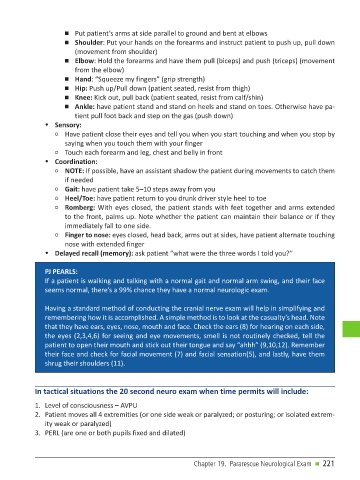Page 223 - PJ MED OPS Handbook 8th Ed
P. 223
n Put patient’s arms at side parallel to ground and bent at elbows
n Shoulder: Put your hands on the forearms and instruct patient to push up, pull down
(movement from shoulder)
n Elbow: Hold the forearms and have them pull (biceps) and push (triceps) (movement
from the elbow)
n Hand: “Squeeze my fingers” (grip strength)
n Hip: Push up/Pull down (patient seated, resist from thigh)
n Knee: Kick out, pull back (patient seated, resist from calf/shin)
n Ankle: have patient stand and stand on heels and stand on toes. Otherwise have pa-
tient pull foot back and step on the gas (push down)
• Sensory:
○ Have patient close their eyes and tell you when you start touching and when you stop by
saying when you touch them with your finger
○ Touch each forearm and leg, chest and belly in front
• Coordination:
○ NOTE: If possible, have an assistant shadow the patient during movements to catch them
if needed
○ Gait: have patient take 5–10 steps away from you
○ Heel/Toe: have patient return to you drunk driver style heel to toe
○ Romberg: With eyes closed, the patient stands with feet together and arms extended
to the front, palms up. Note whether the patient can maintain their balance or if they
immediately fall to one side.
○ Finger to nose: eyes closed, head back, arms out at sides, have patient alternate touching
nose with extended finger
• Delayed recall (memory): ask patient “what were the three words I told you?”
PJ PEARLS:
If a patient is walking and talking with a normal gait and normal arm swing, and their face
seems normal, there’s a 99% chance they have a normal neurologic exam.
Having a standard method of conducting the cranial nerve exam will help in simplifying and
remembering how it is accomplished. A simple method is to look at the casualty’s head. Note
that they have ears, eyes, nose, mouth and face. Check the ears (8) for hearing on each side,
the eyes (2,3,4,6) for seeing and eye movements, smell is not routinely checked, tell the
patient to open their mouth and stick out their tongue and say “ahhh” (9,10,12). Remember
their face and check for facial movement (7) and facial sensation(5), and lastly, have them
shrug their shoulders (11).
In tactical situations the 20 second neuro exam when time permits will include:
1. Level of consciousness – AVPU
2. Patient moves all 4 extremities (or one side weak or paralyzed; or posturing; or isolated extrem-
ity weak or paralyzed)
3. PERL (are one or both pupils fixed and dilated)
Chapter 19. Pararescue Neurological Exam n 221

